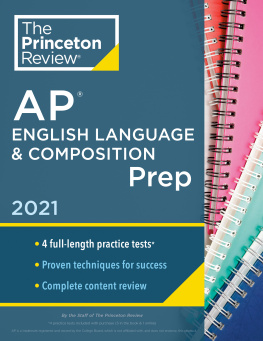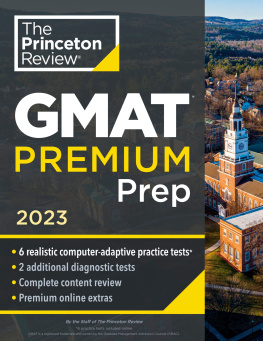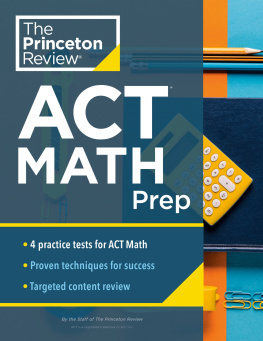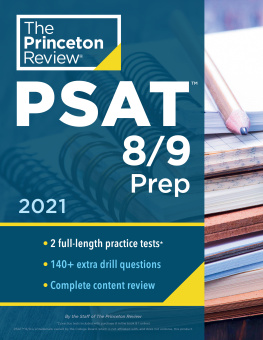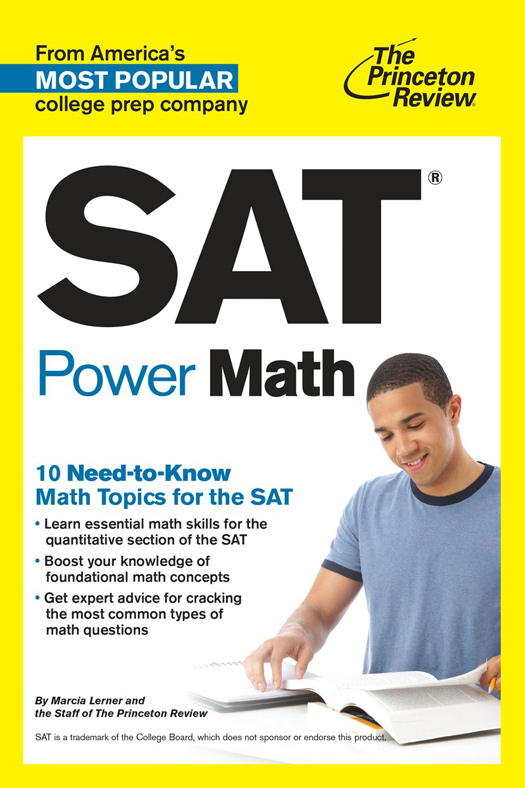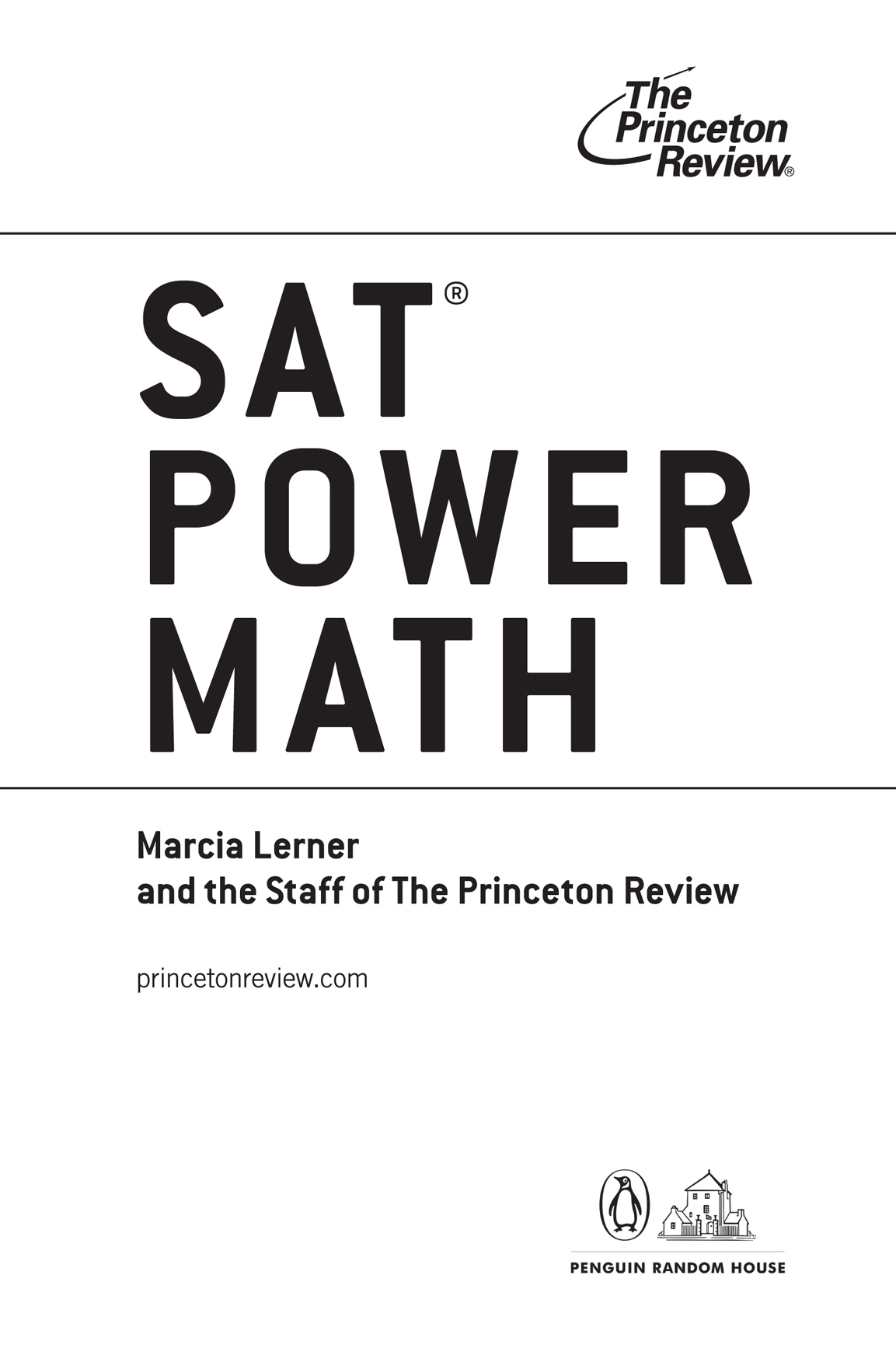Editorial
Rob Franek, Senior VP, Publisher
Casey Cornelius, VP Content Development
Mary Beth Garrick, Director of Production
Selena Coppock, Managing Editor
Calvin Cato, Editor
Colleen Day, Editor
Aaron Riccio, Editor
Meave Shelton, Editor
Orion McBean, Editorial Assistant
Random House Publishing Team
Tom Russell, Publisher
Alison Stoltzfus, Publishing Manager
Melinda Ackell, Associate Managing Editor
Ellen Reed, Production Manager
Kristin Lindner, Production Supervisor
Andrea Lau, Designer
The Princeton Review
24 Prime Parkway, Suite 201
Natick, MA 01760
E-mail:
Copyright 2014 by TPR Education IP Holdings, LLC. All rights reserved.
Cover art Jonathan Pozniak
Published in the United States by Random House, LLC, New York, and simultaneously in Canada by Random House of Canada Limited, Toronto.
A Penguin Random House Company.
eBook ISBN: 978-0-8041-2593-2
Trade Paperback ISBN: 978-0-8041-2592-5
SAT is a registered trademark of the College Board, which does not sponsor or endorse this product.
The Princeton Review is not affiliated with Princeton University.
Some of the content in SAT Power Math has previously appeared in Math Smart, 2nd Edition, published as a trade paperback by Random House in 2001.
Editor: Colleen Day
Production Editor: Harmony Quiroz
Production Artist: Craig Patches
v3.1
Acknowledgments
I would like to gratefully acknowledge the major help from and patience of Hanna Fox, Liz Buffa, Neil Goddin, Paul Foglino, and Jessica Kindred. Also Geoff Martz, Julian Ham, Cynthia Brantley, David Bodnick, Leland Elliott, Grace Roegner, Mike Freedman, Jeannette Mallozzi, Maria Dente, Jennifer Arias, Alice Min, and the staff of The Princeton Review.
Special thanks to Adam Robinson, who conceived of and perfected the Joe Bloggs approach to standardized tests and many of the other successful techniques used by The Princeton Review.
Contents
Introduction
Do you ever tell people, Oh, Im about halfway through the book Im reading? Do you ever say, I dont have enough money to go to the movies? Can you figure out if you have enough time during a television commercial to go to the bathroom and get something out of the refrigerator? Can you tell which is farther away from you, Massachusetts or California? How about if clothes are too big or too small?
If you have thought or figured out even one of these things, you already understand some things about math.
Many people equate the ability to do arithmetic quickly with being math smart. But a calculator or an adding machine can perform mechanical functions quickly. Does this mean something with batteries is smart? Unlikely. Being math smart means understanding how math works. This book reviews some basic math functions; it will help you to do these functions and understand why they work. When youre finished with this book, you will have a better grasp of what math means and how to get through it. A lot of people reading this may be saying, But, the thing is, Im not really a math person.
People like to think of the world, and their brains, as split into two partsthe math and science part, and the English and history part. It doesnt have to be that way. Being math smart doesnt have to do with some specific kind of brain.
You can read The Catcher in the Rye and love it like crazy, and in the next moment figure out that 2 to the third power is equal to 8. Your brain can handle a lot of different things, and just because you are comfortable with one thing doesnt mean you have to be uncomfortable with something else. Math is about patterns that exist in the worldlike the veins on leaves having order. When you see patterns in the world, you are understanding math.
You dont have to love math, although if you relax you may find yourself at least liking it more. But it is a sure thing that you can do math.
So sit down, grab some paper, and relax. If you reach something that confuses you, just back up and read the information that comes before it. Or take a walk around the block, listen to some music, read something else for a while. You can always come back.
How to Use This Book
This book covers the basic underpinnings of math. It covers all the basic math found on the standardized tests you may face trying to go to college (SAT), graduate school (GRE), or business school (GMAT). There are drills throughout, with complete answers and explanations included at the end of each chapter. If there is a chapter that covers something you already feel comfortable with, just do the drill questions to make sure, and then go on to the next chapter. The first seven chapters also contain Approximate This quizzes for you to test your math skills, as well as a list of key terms covered in the chapter. The last chapter of the book will show you how to apply your newly learned math smart skills (and some new skills to boot!) to these standardized tests, specifically the SAT, which is changing in spring 2016. There is also an index in the back of the book.
As of this books printing, relatively little is known about what the redesigned SAT will look like, as the College Board has not released much information. We do know, however, that the new math section will include multi-step questions and some higher-level math (like trigonometry), as well as focus on core math competencies. The redesigned SAT will also allow calculators only for the longer of the two math sections, instead of for every section like the current SAT. Thats why we have dedicated the last chapter of this book to cracking the SAT math section (present and future) and giving you the skills and strategies you need to achieve your best score. And if youre still wondering about the redesigned SAT and what this means for your test preparation, head over the College Boards website, www.collegeboard.org. The Princeton Review website also provides a helpful rundown of the forthcoming changes to the test, which you can find at www.princetonreview.com/SATChanges.
Why The Princeton Review?
We are the worlds leader in test preparation. Each year we help more than two million students score higher through our courses, award-winning software, and best-selling books. Our philosophy is simple: Teach students exactly what they need to know while providing them with an experience that is truly unique and fun. And thats exactly what we plan to do.
Enjoy!
Numbers: An Overview
First get yourself some nice new supplies, such as a fresh pad of paper, some sharp pencils, and one of those giant pink erasers. Not that you need this stuff specifically, its just that nice supplies tend to make you feel better when you do things. Just make sure that regardless of whatever kind of math you do, you write everything down. Writing down math and making it visual are some ways to make math something you can do easily, instead of something that makes you sweat.
You probably dont realize how much you use math in everyday life. You use math when you decide how much time you have to get somewhere, when you decide if you have enough money for both a slice of pizza and a soda, or when you figure out how many minutes need to pass before you get out of class.



